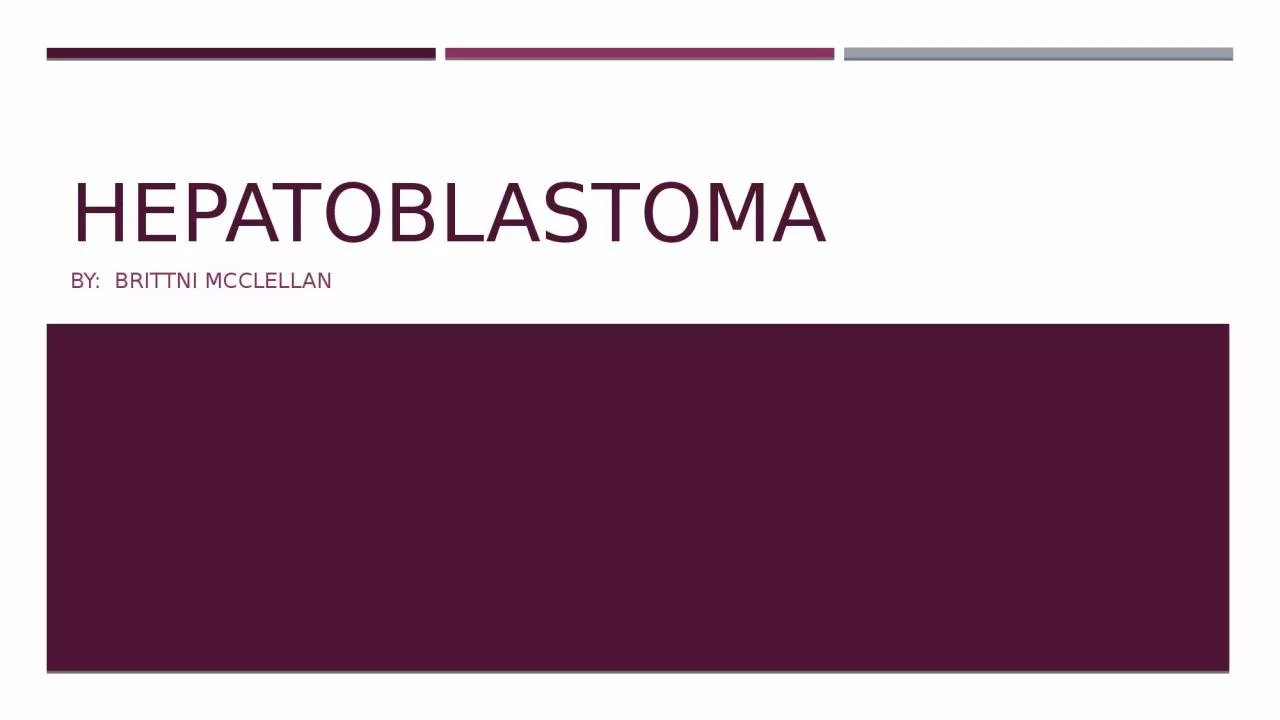

Hepatoblastoma description Description Most common form of liver cancer in children Tumor Marker AFP Can also secrete b hCG Pathophysiology Originate from Immature Liver Precursor Cells Genetics ID: 935220
Download Presentation The PPT/PDF document "hepatoblastoma By: Brittni McClellan" is the property of its rightful owner. Permission is granted to download and print the materials on this web site for personal, non-commercial use only, and to display it on your personal computer provided you do not modify the materials and that you retain all copyright notices contained in the materials. By downloading content from our website, you accept the terms of this agreement.
Slide1
hepatoblastoma
By: Brittni McClellan
Slide2Hepatoblastoma description
Description:
Most common form of liver cancer in children.
Tumor Marker: AFPCan also secrete b-hCGPathophysiology:Originate from Immature Liver Precursor CellsGenetics:Loss of Heterozygosity of the Chromosome Arm 11p.Associated with Beckwith-Wiedemann Syndrome (BWS)
Slide3Hepatoblastoma – H&P
Signs and Symptoms:
Asymptomatic Abdominal Mass
Isosexual Precocity:Penile/Testicular Enlargement without Pubic HairAnorexiaTalipes EquinovarusPersistent Ductus ArteriosusTetralogy of FallotExtrahepatic Biliary AtresiaRenal Anomalies
Slide4Hepatoblastoma - Diagnosis
Diagnosis:
CBC:
Normochromic Normocytic AnemiaThrombocytosisOther LabsLiver Enzyme Levels Elevated in 15-30%AFPAs high as 100,000-300,000Biopsy:Open Biopsy or Complete Surgical Resection
Imaging:
Radiography:
Mass in RUQ of Abdomen
U/S:
CT:
Reveals involvement of nearby structures
Reveals if Pulmonary Metastases are present
MRI:
Superior to CT if CT is inconclusive.PET:Follow-Up EvaluationRadionuclide Bone Scanning:Reveals Bone Metastases
Slide5Hepatoblastoma – treatment
Medication:
Cisplatin: Most active single agent
Cisplatin/5-FU/Vincristine ComboRadiotherapyResection/Transplantation
Slide6Neuroblastoma description
Description:
Most Common
Extracranial Solid Tumor of ChildhoodMost Common Malignancy of InfancyPathophysiology:Derived from Neural Crest CellsArises anywhere along the Sympathetic Chain of the Peripheral Nervous SystemMost Common: Adrenal MedullaGenetics: Due to Inherited Mutations in the ALK Tyrosine Kinase
Associated with N-MYC OncogeneAssociated with Congenital Central Hypoventilation Syndrome and PHOX2B Mutations.
Small Round Blue Cell Tumor
Homer Wright Rosettes
Bombesin
+
Slide7neuroblastoma – H&P
History:
General Appearance, Activity Level, and Appetite
Based on Tumor Location:Thoracic:Chest Pain, Cough, Respiratory DistressAbdominal:Pain, SwellingBone Marrow:Fatigue (Anemia)Associated ConditionsNeurofibromatosis Type IHirschsprung Disease
Central Congenital Hypoventilation Syndrome
Signs and Symptoms:
Based on Location:
Abdomen:
Firm, Fixed, Irregular Mass
Abdominal Distention
Signs of Bowel Obstruction
Hypertension (RAS)
Genital/Lower Extremity Edema (Lymphatic Obstruction)Cervical/Thoracic Mass:Respiratory DistressHorner SyndromeSuperior Vena Cava SyndromeParaspinal Mass:
Nerve Root CompressionMetastatic Disease SymptomsBone Metastases (Pain)Bony Orbit
Slide8neuroblastoma – H&P
Slide9neuroblastoma - Diagnosis
Diagnosis:
CBC:
Decreased Hemoglobin, Platelets, and/or WBC indicate Bone Marrow InvolvementUrine Catecholamine Metabolites are Elevated:Homovanillic Acid (HVA)Vanillylmandelic Acid (VMA)ImagingU/S or CT: Find Primary TumorTumor is CALCIFIEDMIBG Scan:
Taken up by 90% of NeuroblastomasCan detect bone/soft tissue involvementBone Scan: Find Bone Mets
Slide10neuroblastoma – treatment
Medication
Vincristine, Doxorubicin, Cyclophosphamide, Cisplatin, Carboplatin. Etoposide, Topotecan
13-cis-Retinoic Acid: Induces differentiation of Neuroblastoma Cells and Improves Survival Immunotherapy: Antibodies against GD2Possibility of Spontaneous Regression
Slide11retinoblastoma description
Description:
Most Common Primary Intraocular Tumor
Malignant Tumor of the Embryonic Neural RetinaPathophysiology:Loss of function of both copies of the RB1 gene Located on Chromosome 13Spreads via the Optic NerveVitreous Seeding: Tumor Cells Break OffTwo Forms:Hereditary Retinoblastoma
45% of all RB1 RB Gene is Dysfunctional in all cellsNon-Hereditary Retinoblastoma55% of all RB2 acquired mutations must occur in a single retinal cell.
Slide12retinoblastoma – H&P
Patient History:
Family History
Leukocoria (White Pupil)StrabismusRare: Pain, Inflammation, Vision ProblemsMetastatic Symptoms:Neurological Signs, Orbital Masses, Bone Pain, Anorexia, CytopeniaAssociated Conditions:13q Deletion SyndromeRB, Dysmorphism, Mental Retardation, GU AnomaliesHigh Risk of Osteosarcoma in the Future
Physical Exam:Only 3% discovered on routine fundoscopic examinationLeukocoria/StrabismusCheck for Red Reflex in Darkened RoomScreen for RB in OfficeEvaluate AnisocoriaUnequal Pupils
Slide13retinoblastoma - Diagnosis
Diagnosis:
Ophthalmologic Examination
By a specialist in pediatric ocular tumorsBiopsy:Biopsy confirmation is RARE.Risk of seedingCBC:Asses for Bone Marrow involvementCSF CytologyEvaluation of Leptomeningeal SpreadChromosome AnalysisOnly 5% are detectable, but should be done anyways.
Imaging:
CT/MRI:
Evaluation of Primary Tumor
Evaluation of any metastases.
Slide14retinoblastoma – treatment
Medication
Eradicate Tumor/Eye Salvage Therapy
Plaque Radiotherapy: Radioactive seeds sewn into episcleral surface about RB lesion.Provides local radiation to the tumorExternal Beam Radiation TherapyPhotocoagulation:CryotherapyLocally Delivered ChemotherapySystemic Chemotherapy
Tumor Resection with Enucleation
Slide15Wilms tumor (Nephroblastoma) description
Description:
Malignant Tumor of the Kidney
Also called NephroblastomaPathophysiology:10-20% Hereditary Associated with WAGR, Beckwith-Wiedemann, and Denys-Drash SyndromesTumor Suppressor Gene: WT1 on Chromosome 11p13WT2 on Chromosome 11p15
Slide16Wilms tumor – H&P
Patient History:
Family History
Abdominal Distention/PainHematuriaFever, Anorexia, VomitingRapid Increase in Abdominal SizePhysical Exam:Asymptomatic Abdominal MassExtends from Flank Towards Midline
AnemiaFeverHypertensionVaricoceleAniridia, Hemihypertrophy, Cryptorchidism, HypospadiasProteinuria/Hematuria
Slide17Wilms tumor - Diagnosis
Diagnosis:
Labs:
CBC, Electrolytes, Urine Analysis, Liver and Kidney Function Tests, Coagulation FactorsImaging:U/S:Diagnostic of Renal MassEvaluations extention into Inferior Vena CavaCT Scan:Evaluate for MetastasesBone Scan:Evaluate for Metastases
Pathology:
CT/MRI:
Gross:
Cystic with hemorrhages and necrosis.
No calcification
May extend into Inferior Vena Cava
Histology:
Triphasic Pattern: Blastemal, Epithelial, and Stroma Cells
Blastemal Cells aggregate in nodules like primitive glomeruliThe presence of diffuse anaplasia indicates poor prognosis.
Slide18Wilms tumor – treatment
Medication
For stages I and II:
Vincristine and Actinomycin D every 3 weeks for 6 months For stages III and IV: Vincristine, Actinomycin D, and Doxorubicin for 6–15 months Add cyclophosphamide and/or Etoposide for higher-stage anaplastic tumors (stage IV focal or II–IV diffuse). NephrectomyRadiotherapy
Slide19Neuroblastoma vs wilms tumor
Slide20Question 1
A 2-year-old girl is brought to the office by her parents after blood was noticed in her urine. The parents say the patient has had intermittent abdominal pain during the past two months but has been otherwise well. On physical examination, the abdomen is slightly distended and a mass is palpated in the right upper quadrant. Results of urinalysis are positive for blood and protein. Which of the following is the most likely diagnosis?
Cystic nephroma
Cystitis
Mesoblastic nephromaNeuroblastomaWilms tumor
e) Wilms tumor
Slide21Question 2
A 3-year-old boy is found to have an abnormal red reflex in his left eye on routine examination. Funduscopic examination shows a proliferative retinal mass. After surgical removal of the specimen, pathologic examination reveals small, round cells with hyperchromatic nuclei, some rosette arrangement and isolated regions of necrosis. There is no involvement of the optic nerve or tumor extension into adjacent brain tissue. The patient undergoes eye enucleation without surgical complications.
As the child ages, which of the following disorders is the patient also at risk for developing?
Acoustic neuroma.
Colon cancer.Neurofibroma.Osteosarcoma.Wilms tumor.
d) Osteosarcoma